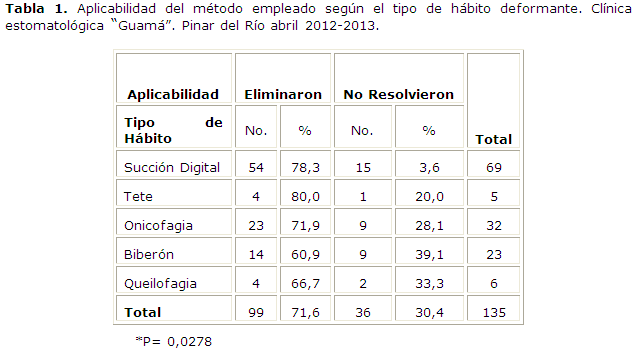Treatment of oral deforming habits using auriculotherapy
Keywords:
Auriculotherapy/statistics & numerical data, Habits.Abstract
Introduction: known as Chinese natural and traditional medicine in current times, in Asia was simply known as medicine, without last names. Throughout the history, human being has tried to get rid of disease calamity, therefore different therapies preserving their bases are used. Among them auriculotherapy is found.Objective: to assess the auriculotherapy to eliminate deforming oral habits: factors provoking entomaxillofacial anomalies.
Material and method: a descriptive, longitudinal, prospective and monocentric study was conducted in 116 patients (children) belonging to Luis Augusto Turcios Lima university polyclinic, Pinar del Río. These children attended to the orthodontia office from April 15, 2012 to April 15, 2013 having one or more associated oral deforming habits. Auriculotherapy was applied to assess the effectiveness of this method. They were followed up during 6 months to confirm the elimination of oral deforming habits. Results were statistically processed using the automated system of statistics and chi-square test in its application of goodness of fit. A level of significance 0, 05 was arranged in all cases in advance.
Results: oral deforming habits were eliminated using auriculotherapy technique, it was applicable for digital sucking (96,4%) and nail biting (95,8%). Girls practiced these deforming habits more than boys where familial influence helped or made it difficul the final result of the treatment.
Conclusions: auriculotherapy was effective to eliminate the majority of habits related to digital sucking and nail biting.
Downloads
References
1. Abreu F. Medicina natural, tradicional y alternativa: una aproximación desde nuestra ciencia. En: De Melo, O. Medicina sin apellidos: Un debate sobre la medicina natural y tradicional en Cuba. La Habana: Editorial UH; 2013. P.25-26.
2. Bedoya N, Chacón A. Tratamiento temprano de maloclusiones clase II tratado con activador abierto elástico de Klammt (AAEK). Reporte de caso. Rev Estomat. [Internet]. 2009 [citado 12 Oct 2011]; 17(2): [Aprox. 8 p.]. Disponible en: http://bibliotecadigital.univalle.edu.co/xmlui /handle/10893/2385
3. Otaño Lugo, R. Interferencias oclusales en la dentición temporal. En: Otaño Lugo, R. Manual clínico de ortodoncia. Cap.16.La Habana: Editorial Ciencias Médicas, 2008 p.256-257.
4. Martín Cid C, Barbería Leache E, González Sanz A, Rioboó García R. Prevalencia de maloclusiones en niños de la Comunidad Autónoma de Madrid según el índice estético dental. Rev Española Ortod. [Internet]. 2009 [citado 12 Oct 2011]; 39(2): [Aprox. 11p.]. Disponible en: http://dialnet.unirioja.es/servlet/articulo?codigo=3037719
5. García Díaz C, Duque Alberro Y, Llanes Serantes M, Vinent González R. Prevalencia de anomalías dentomaxilofaciales en los niños menores de 14 años. Rev Ciencias Médicas. [Internet]. 2011 [Citado 12 Oct 2011]; 15(2): [aprox. 2 p]. Disponible en: http://scielo.sld.cu/scielo.php?pid=S1561-31942011000200007&script=sci_arttext&tlng=en
6. Martínez Rodríguez M, Pérez Martínez A, Vinent Gonzàlez R. Factores de riesgo asociados con anomalías de oclusión en dentición temporal: Círculo XI Festival 2012 Rev Universidad Médica Pinareña. [Internet].2012 [citado 12 Oct 2011]; 8(2): [aprox 2-3 p]. Disponible en: http://galeno.pri.sld.cu/index.php/galeno/article/view/73/59
7. Escobar F, Werner A. Mordida cruzada anterior en dentición temporal. Revista Mexicana de Odontologia Clínica. [Internet] 2009 [citado 4 enero 2012]; 3(5) Disponible en: http://www.intramed.net/contenidover.asp?contenidoID=63138
8. Vaca Torres J L. Efectividad de la auriculoterapia como tratamiento para el sobrepeso y la obesidad. Revisión sistemática de la literatura. Universidad nacional de Colombia Facultad de Medicina Bogotá, Colombia. [Internet] 2011 [citado 4 enero 2012]. Disponible en: http://www.bdigital.unal.edu.co/7244/1/598620.2012.pdf
9. de Armas Molerio I de la C, Bello Medina B, Guevara de León B, de Armas Sáez M, Yasoda Endo Milán J, Gómez Villar M.J et al. Efectividad de la auriculoterapia en pacientes hipertensos ligeros y moderados Acta Médica del Centro ìnternet]. 2013 [citado 4 enero 2012]; 7(2): [aprox 1-2 p]. Disponible en: http://www.actamedica.sld.cu/r2_13/pdf/auriculoterapia.pdf
10. Gómez Martínez N, Gómez Martínez N. La auriculoterapia en el anciano con glaucoma, una estrategia terapéutica para disminuir la polifarmacia. GeroInffo Publicación Periódica de Gerontología y Geriatría RNPS 2110. [Internet]. 2013 [citado 4 Enero 2012]; 8(2): [aprox. 2p] Disponible en: http://files.sld.cu/gericuba/files/2013/08/auriculoterapia-y-glaucoma-en-pm.pdf
11. Sari E, Sari T. The role of acupuncture in the treatment of orthodontic Patients with a gagging reflex: a pilot study. Br Dent J. 2010 May 22; 208 (10):E1.
12. Santiago Cepero A, Torres Ulloa M, Álvarez Curbelo M, Cubero González R, López Martín D. Factores de mayor riesgo para maloclusiones dentarias desde la dentición temporal. Clínica Estomatológica Docente de Ciego de Ávila. [Internet]. 2010 [Citado Agosto 15, 2012]; 16 (Supl.1). Disponible en: http://bvs.sld.cu/revistas/mciego/vol16_supl1_10/rev/t-17.html

Published
How to Cite
Issue
Section
License
Authors who have publications with this journal agree to the following terms: Authors will retain their copyrights and grant the journal the right of first publication of their work, which will be publication of their work, which will be simultaneously subject to the Creative Commons Attribution License (CC-BY-NC 4.0) that allows third parties to share the work as long as its author and first publication in this journal are indicated.
Authors may adopt other non-exclusive license agreements for distribution of the published version of the work (e.g.: deposit it in an institutional telematic archive or publish it in a volume). Likewise, and according to the recommendations of the Medical Sciences Editorial (ECIMED), authors must declare in each article their contribution according to the CRediT taxonomy (contributor roles). This taxonomy includes 14 roles, which can be used to represent the tasks typically performed by contributors in scientific academic production. It should be consulted in monograph) whenever initial publication in this journal is indicated. Authors are allowed and encouraged to disseminate their work through the Internet (e.g., in institutional telematic archives or on their web page) before and during the submission process, which may produce interesting exchanges and increase citations of the published work. (See The effect of open access). https://casrai.org/credit/


